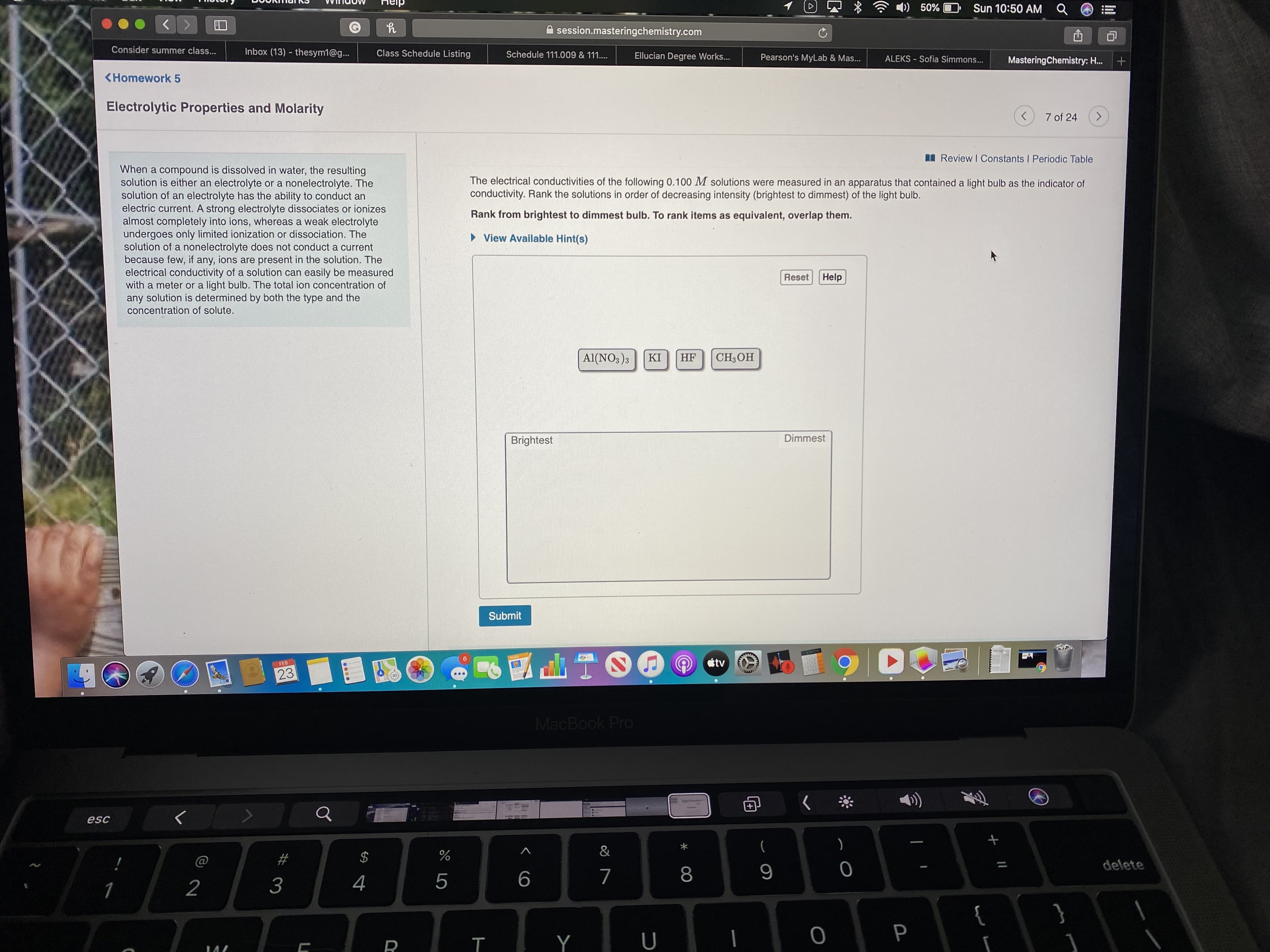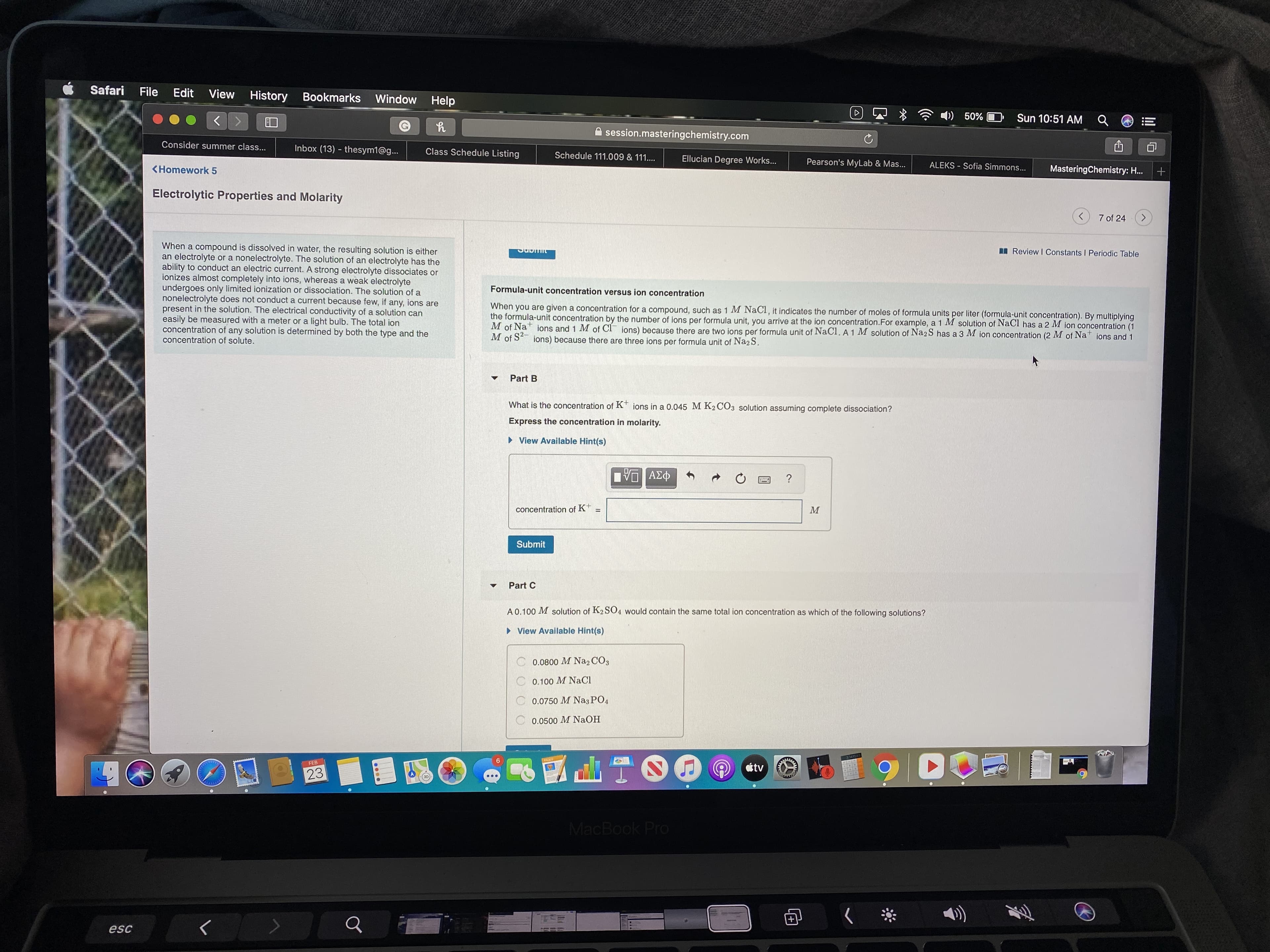4)) 50% Sun 10:50 AM Q session.masteringchemistry.com Consider summer class... Inbox (13) - thesym1@g... Class Schedule Listing Schedule 111.009 & 111.... Ellucian Degree Works... Pearson's MyLab & Mas... ALEKS - Sofia Simmons... MasteringChemistry: H. I Review I Constants I Periodic Table When a compound is dissolved in water, the resulting solution is either an electrolyte or a nonelectrolyte. The solution of an electrolyte has the ability to conduct an electric current. A strong electrolyte dissociates or ionizes almost completely into ions, whereas a weak electrolyte undergoes only limited ionization or dissociation. The solution of a nonelectrolyte does not conduct a current because few, if any, ions are present in the solution. The electrical conductivity of a solution can easily be measured with a meter or a light bulb. The total ion concentration of any solution is determined by both the type and the concentration of solute. The electrical conductivities of the following 0.100 M solutions were measured in an apparatus that contained a light bulb as the indicator of conductivity. Rank the solutions in order of decreasing intensity (brightest to dimmest) of the light bulb. Rank from brightest to dimmest bulb. To rank items as equivalent, overlap them. • View Available Hint(s) Reset Help Al(NO3)3 KI HF CH;OH Brightest Dimmest Submit tv FEB 23 MacBook Pro esc & ( @ 23 24 delete 8 1 2 3 4 { } Safari File Edit View History Bookmarks Window Help )) 50% Sun 10:51 AM session.masteringchemistry.com Consider summer class... Inbox (13) - thesym1@g... Class Schedule Listing Schedule 111.009 & 111.. Ellucian Degree Works... Pearson's MyLab & Mas... ALEKS - Sofia Simmons... View Available Hint(s) νο ΑΣφ concentration of K+ Submit Part C A 0.100 M solution of K2SO4 would contain the same total ion concentration as which of the following solutions? > View Available Hint(s) 0.0800 M Na2 CỐ3 C 0.100 M NaCl 0.0750 M NazPO4 0.0500 M NaOH FEB tv 23 MacBook Pro esc
4)) 50% Sun 10:50 AM Q session.masteringchemistry.com Consider summer class... Inbox (13) - thesym1@g... Class Schedule Listing Schedule 111.009 & 111.... Ellucian Degree Works... Pearson's MyLab & Mas... ALEKS - Sofia Simmons... MasteringChemistry: H. I Review I Constants I Periodic Table When a compound is dissolved in water, the resulting solution is either an electrolyte or a nonelectrolyte. The solution of an electrolyte has the ability to conduct an electric current. A strong electrolyte dissociates or ionizes almost completely into ions, whereas a weak electrolyte undergoes only limited ionization or dissociation. The solution of a nonelectrolyte does not conduct a current because few, if any, ions are present in the solution. The electrical conductivity of a solution can easily be measured with a meter or a light bulb. The total ion concentration of any solution is determined by both the type and the concentration of solute. The electrical conductivities of the following 0.100 M solutions were measured in an apparatus that contained a light bulb as the indicator of conductivity. Rank the solutions in order of decreasing intensity (brightest to dimmest) of the light bulb. Rank from brightest to dimmest bulb. To rank items as equivalent, overlap them. • View Available Hint(s) Reset Help Al(NO3)3 KI HF CH;OH Brightest Dimmest Submit tv FEB 23 MacBook Pro esc & ( @ 23 24 delete 8 1 2 3 4 { } Safari File Edit View History Bookmarks Window Help )) 50% Sun 10:51 AM session.masteringchemistry.com Consider summer class... Inbox (13) - thesym1@g... Class Schedule Listing Schedule 111.009 & 111.. Ellucian Degree Works... Pearson's MyLab & Mas... ALEKS - Sofia Simmons... View Available Hint(s) νο ΑΣφ concentration of K+ Submit Part C A 0.100 M solution of K2SO4 would contain the same total ion concentration as which of the following solutions? > View Available Hint(s) 0.0800 M Na2 CỐ3 C 0.100 M NaCl 0.0750 M NazPO4 0.0500 M NaOH FEB tv 23 MacBook Pro esc
Principles of Instrumental Analysis
7th Edition
ISBN:9781305577213
Author:Douglas A. Skoog, F. James Holler, Stanley R. Crouch
Publisher:Douglas A. Skoog, F. James Holler, Stanley R. Crouch
Chapter33: Automated Methods Of Analysis
Section: Chapter Questions
Problem 33.6QAP
Related questions
Question

Transcribed Image Text:4)) 50%
Sun 10:50 AM Q
session.masteringchemistry.com
Consider summer class...
Inbox (13) - thesym1@g...
Class Schedule Listing
Schedule 111.009 & 111....
Ellucian Degree Works...
Pearson's MyLab & Mas...
ALEKS - Sofia Simmons...
MasteringChemistry: H.
<Homework 5
Electrolytic Properties and Molarity
7 of 24
<>
I Review I Constants I Periodic Table
When a compound is dissolved in water, the resulting
solution is either an electrolyte or a nonelectrolyte. The
solution of an electrolyte has the ability to conduct an
electric current. A strong electrolyte dissociates or ionizes
almost completely into ions, whereas a weak electrolyte
undergoes only limited ionization or dissociation. The
solution of a nonelectrolyte does not conduct a current
because few, if any, ions are present in the solution. The
electrical conductivity of a solution can easily be measured
with a meter or a light bulb. The total ion concentration of
any solution is determined by both the type and the
concentration of solute.
The electrical conductivities of the following 0.100 M solutions were measured in an apparatus that contained a light bulb as the indicator of
conductivity. Rank the solutions in order of decreasing intensity (brightest to dimmest) of the light bulb.
Rank from brightest to dimmest bulb. To rank items as equivalent, overlap them.
• View Available Hint(s)
Reset
Help
Al(NO3)3
KI
HF
CH;OH
Brightest
Dimmest
Submit
tv
FEB
23
MacBook Pro
esc
&
(
@
23
24
delete
8
1
2
3
4
{
}

Transcribed Image Text:Safari
File
Edit
View History Bookmarks
Window
Help
)) 50%
Sun 10:51 AM
session.masteringchemistry.com
Consider summer class...
Inbox (13) - thesym1@g...
Class Schedule Listing
Schedule 111.009 & 111..
Ellucian Degree Works...
Pearson's MyLab & Mas...
ALEKS - Sofia Simmons...
<Homework 5
MasteringChemistry: H.
Electrolytic Properties and Molarity
7 of 24
When a compound is dissolved in water, the resulting solution is either
an electrolyte or a nonelectrolyte. The solution of an electrolyte has the
ability to conduct an electric current. A strong electrolyte dissociates or
ionizes almost completely into ions, whereas a weak electrolyte
undergoes only limited ionization or dissociation. The solution of a
nonelectrolyte does not conduct a current because few, if any, ions are
present in the solution. The electrical conductivity of a solution can
easily be measured with a meter or a light bulb. The total ion
concentration of any solution is determined by both the type and the
concentration of solute.
I Review I Constants I Periodic Table
Formula-unit concentration versus ion concentration
When you are given a concentration for a compound, such as 1 M NaCI, it indicates the number of moles of formula units per liter (formula-unit concentration). By multiplying
the formula-unit concentration by the number of ions per formula unit, you arrive at the ion concentration.For example, a 1 M solution of NaCl has a 2 M jon concentration (1
M of Na ions and 1 M of CI ions) because there are two ions per formula unit of NaCl. A 1 M solution of Na2 S has a 3 M ion concentration (2 M of Na
M of S ions) because there are three ions per formula unit of Na2S.
ions and 1
Part B
What is the concentration of K* ions in a 0.045 M K2 CO3 solution assuming complete dissociation?
Express the concentration in molarity.
> View Available Hint(s)
νο ΑΣφ
concentration of K+
Submit
Part C
A 0.100 M solution of K2SO4 would contain the same total ion concentration as which of the following solutions?
> View Available Hint(s)
0.0800 M Na2 CỐ3
C 0.100 M NaCl
0.0750 M NazPO4
0.0500 M NaOH
FEB
tv
23
MacBook Pro
esc
Expert Solution
This question has been solved!
Explore an expertly crafted, step-by-step solution for a thorough understanding of key concepts.
This is a popular solution!
Trending now
This is a popular solution!
Step by step
Solved in 4 steps with 13 images

Recommended textbooks for you

Principles of Instrumental Analysis
Chemistry
ISBN:
9781305577213
Author:
Douglas A. Skoog, F. James Holler, Stanley R. Crouch
Publisher:
Cengage Learning


Principles of Instrumental Analysis
Chemistry
ISBN:
9781305577213
Author:
Douglas A. Skoog, F. James Holler, Stanley R. Crouch
Publisher:
Cengage Learning
